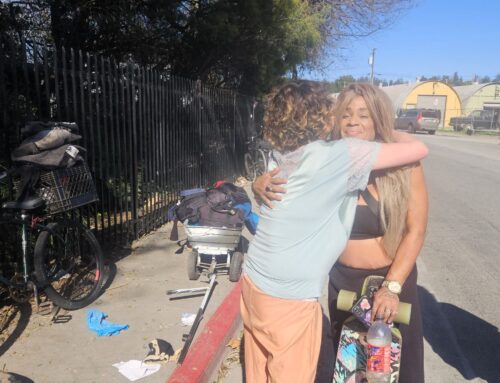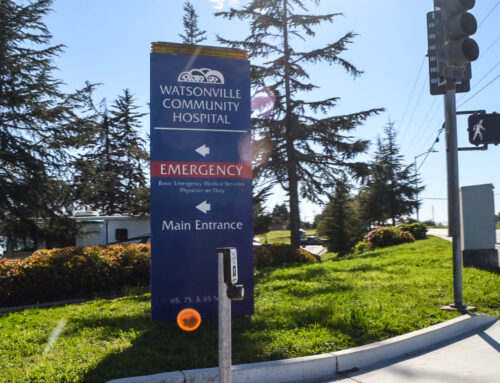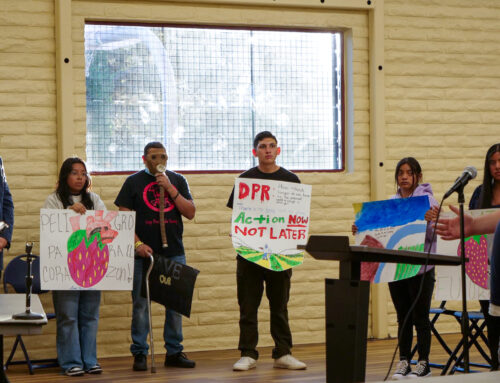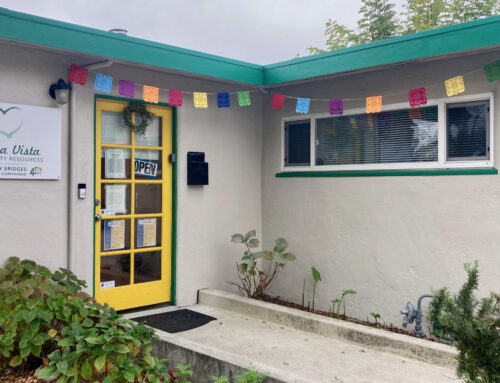Santa Cruz Local offers its news stories free as a public service. We depend on people like you — we call them our Santa Cruz Local members — to chip in $9 a month or $99 a year so vital information can be available to all. Can we count on your help?
Editor’s note: This story was updated Dec. 18.
A state stay-at-home order issued this month took effect Thursday night in Santa Cruz County, since the Bay Area region’s intensive care unit capacity dropped below the 15% threshold Wednesday.
The state order groups Santa Cruz County with 10 other San Francisco Bay Area counties, including Monterey. The region’s intensive care unit capacity has dropped from 25.3% Dec. 3 to 12.9% Wednesday. Capacity is updated daily on the state’s website.
The order states:
- Residents must not gather with people outside their household.
- Residents must stay home unless they are working in “critical infrastructure” defined by types of businesses.
- Shops cannot operate indoors at more than 20% capacity.
- Schools already open for in-person instruction may remain open.
- Child care and non-urgent medical and dental care may remain open, with precautions.
Scroll down for answers to Santa Cruz Local reader questions.
- What does the stay-at-home order mean?
- What is the intensive care capacity in Santa Cruz County hospitals?
- What businesses and activities will be affected?
- How will it be enforced?
- Will beaches or parks close?
- Can I go for a walk with people I don’t live with if we wear masks and stay 6 feet apart?
- How does the order apply to me if I’m homeless?
- Can I visit my vacation home in Santa Cruz?
- My husband and I live on the same property in our own house next door to my single-parent son. Our grandkids come for half the week. Must we remain secluded from them?
- Does the curfew still apply?
- Can we drive around and look at Christmas decorations, as long as it’s only with people in our household?
- Can I continue to play tennis with the same people I’ve been playing with?
- Can I go to Santa Cruz from a neighboring county to spend the day at the beach fishing with my kids?
- Is meeting one other person considered a prohibited gathering?
- Submit your questions here.
What the stay-at-home order means
The order is meant to protect hospital capacity in California as COVID-19 surges and fills intensive care units across the country. The order takes effect 24 hours after the Bay Area region hits the 15% threshold.
It lasts for at least three weeks and will continue until state four-week projections of the region’s intensive care unit capacity is 15%.
(top)
Santa Cruz County hospitals
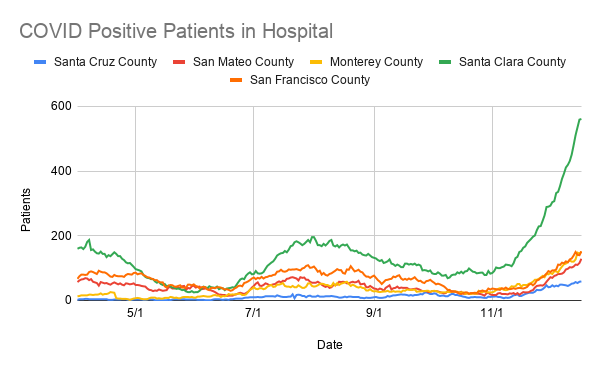
Thursday, there were 59 COVID patients in Santa Cruz County hospitals, according to a state department of public health dashboard. Intensive care units in Santa Cruz County had 12 COVID patients and two ICU beds available, according to the state.
Santa Cruz County Deputy Health Officer Dr. David Ghilarducci said in a news conference Thursday that the state data dashboard sometimes lags real-time numbers that fluctuate quickly. Ghilarducci said Dominican Hospital and Watsonville Community Hospital have added beds to their intensive care units. The limiting factor is staff.
Previously, Santa Cruz County hospitals could rely on transfers to intensive care units in the region. That is no longer the case.
“Most hospitals are no longer able to accept transfers. So Santa Cruz County has to be as self-sufficient as possible,” Ghilarducci said.
Since February, local public health leaders have seen a surge of cases within two weeks of major holidays, said Santa Cruz County Chief of Public Health Jennifer Herrera in a news conference Dec. 10. What’s worrisome — about two weeks after Thanksgiving — is that local intensive care units are near capacity, Herrera said.
“We don’t have enough of a buffer time between holidays to actually let cases die down, so we’re worried about that. And we’re worried that even if it’s not COVID-19, if someone needs to be hospitalized or seek care, that our health care system won’t be able to handle it,” Herrera said.
She urged families to consider alternate plans for the December holidays.
“It’s really hard to not do your family traditions, including for myself. It’s hard to not do that this year. But it’s something to really consider,” Herrera said. “Can we do a virtual cookie exchange? Can we do a virtual meetup with our family members? I encourage people to have conversations with their families and decide what works best for them.”
(top)
What businesses and activities will be affected?
- Outdoor recreational facilities, including gyms: Outdoor operation only, without any food, drink or alcohol sales. Campgrounds will be closed.
- Retail: Indoor operations allowed at 20% capacity, and 35% capacity for grocery stores.
- Shopping centers: Indoor operations allowed at 20% capacity.
- Hotels and lodging: Out-of-state reservations for nonessential travel not allowed, unless the reservation is for at least 14 days to allow quarantine.
- Restaurants, including coffee shops: Only pickup or delivery.
- Offices: Only open for critical infrastructure sectors in which remote working is not possible.
- Places of worship and political expression: No indoor activities allowed.
- Hair salons and barbershops: Closed
- Personal care services such as nail salons, skin care spas, tattoo parlors and massage studios in non-healthcare settings: Closed
- Museums, zoos and aquariums: Closed
- Movie theaters (except drive-in): Closed
- Wineries, bars, breweries, and distilleries (with exception for production, manufacturing, distribution, and retail sale for off-site consumption): Closed
- Family entertainment centers: Closed
- Cardrooms: Closed
- Live audience sports: Closed
- Amusement parks: Closed
- Youth sports: Outdoor operation only with restrictions.
- Farmers markets: May remain open with modifications.
- Libraries: Considered retail and should follow capacity limits.
- Pet grooming: Closed
- Residential and janitorial cleaning services: May remain open.
- Funeral homes: Considered critical infrastructure and may remain open.
- Real estate: May offer in-person showings to individual prospective buyers only. Open houses not allowed.
(top)
How will it be enforced?
Authorities in the county have two tools: a misdemeanor violation of a health officer order and an infraction, approved by the county board of supervisors earlier this year, county spokesman Jason Hoppin wrote in an email.
“Enforcement will be up to the sheriff and staff designated to issue infractions. As always, we’re going to rely on education,” Hoppin wrote.
(top)
Will beaches or parks close?
Beaches, parks and playgrounds would remain open, unless county officials issue a separate local order, Hoppin wrote.
(top)
Can I go for a walk with people I don’t live with, as long as we wear masks and stay 6 feet apart?
“The strict definition or strict guidelines of the order are that households are not to mix, even for outdoor recreational activities,” said Santa Cruz County Health Officer Dr. Gail Newel, in a news conference Thursday. “But our harm reduction messaging is that if you choose to spend time with people outside of your household, that you do it outdoors, and while you’re active.”
The order allows people to leave their homes, “as long as they do not engage in any interaction with (or otherwise gather with) any number of persons from any other household, except as specifically permitted”.
Enforcement is up to local authorities.
The state public health department has a slightly different message. A representative on the state’s COVID information hotline said Wednesday that the state does not recommend such exercise, but it does not prohibit it.
The state’s frequently-asked questions page states:
“Members of the same household are encouraged to maintain physical and mental health by safely going to a park, a beach, hike, walk, or bike ride with members of their own household.”
A June 24 county health officer order requires people to wear face coverings in public and in many cases at work. A face covering is recommended but not required during exercise.
(top)
How does the order apply to me if I’m homeless?
The order does not apply to those who are homeless. Shelter, housing and other resources for people without shelter are listed on the county’s human services department page.
To reach someone directly about shelter or housing:
- People ages 18 to 24: Christina Salibi – 831-465-4182, [email protected]
- Families or people ages 18-24: Erik Lua – 831-740-7340, [email protected]. Lua’s hours are 1-3 p.m. Mondays and Wednesdays.
- South County: Monique Sanchez – 831-322-9897, [email protected]
- North County: Alejandro Grijalva — 831-325-2904, [email protected]
- General COVID-19 Homeless Response hotline: 831-291-5098, [email protected]
(top)
Can I visit my vacation home in Santa Cruz?
“Californians are encouraged to stay home or in their region and avoid non-essential travel,” a California Department of Public Health representative wrote in an email to Santa Cruz Local. “Avoiding travel can reduce the risk of virus transmission. Please find out more about the travel advisory here.”
The state public health department considers recreational travel non-essential. It defines essential travel as “work and study, critical infrastructure support, economic services and supply chains, health, immediate medical care, and safety and security.”
The state health department’s Nov. 13 travel advisory states that people who arrive in California should quarantine for 14 days and limit their interactions to their own household.
(top)
My husband and I live on the same property in our own house next door to my single-parent son. Our grandkids come for half the week. Must we remain secluded from them?
A state public health representative stated that the order prohibits private gatherings of any size.
(top)
Does the curfew still apply?
A curfew that started Nov. 21 prohibited gatherings outside the home between 10 a.m. and 5 p.m. for counties in the purple tier, including Santa Cruz County. The new order is more restrictive and prohibits gatherings at all times.
(top)
Can we drive around and look at Christmas decorations, as long as it’s only with people in our household?
Yes, said Newel, as long as you stay in your car. Drive-in movies and drive-through events such as the lights at the Santa Cruz County Fairgrounds are allowed.
(top)
Can I continue to play tennis with the same people I’ve been playing with?
No. The only sports that are allowed for the general public are within your own household, Newel said.
(top)
Can I go to Santa Cruz from a neighboring county to spend the day at the beach fishing with my kids?
State officials recommend against it. The state’s travel advisory is in effect, which encourages Californians to avoid “non-essential travel.” The state public health department considers recreational travel non-essential.
(top)
Is meeting one other person considered a prohibited gathering?
Yes it is prohibited. The order allows people to leave their homes, “as long as they do not engage in any interaction with (or otherwise gather with) any number of persons from any other household.”
Enforcement is up to local authorities.
More information is posted on the state’s frequently-asked questions page.
(top)
We want to hear from you.
(top)
Kara Meyberg Guzman is the CEO and co-founder of Santa Cruz Local. Prior to Santa Cruz Local, she served as the Santa Cruz Sentinel’s managing editor. She has a biology degree from Stanford University and lives in Santa Cruz.


